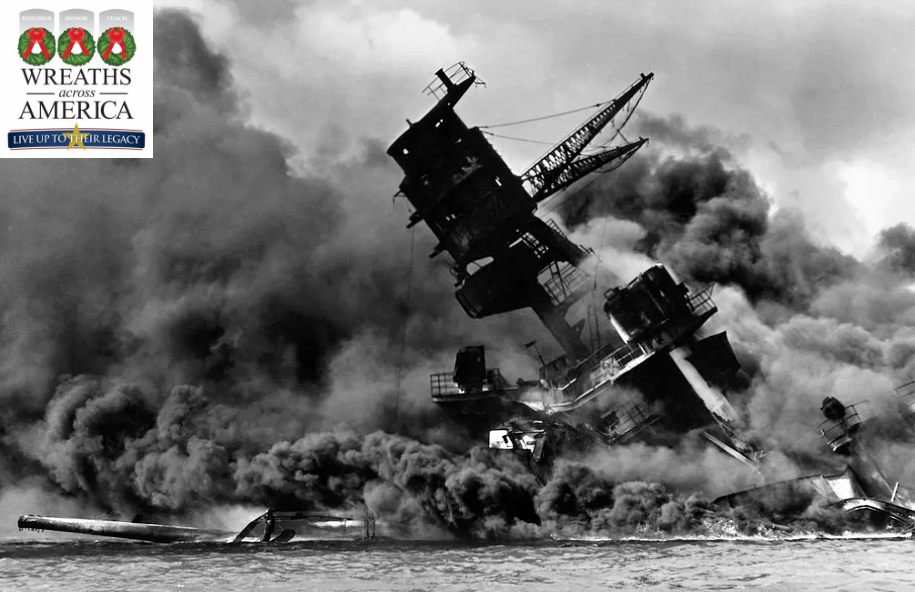December 7, 2021
The 80th anniversary of the attack on Pearl Harbor remembered
Texas high school band performs
Contributed
Wreaths Across America and the George Bush Presidential Library and Museum marked the 80th anniversary of the attack on Pearl Harbor and entry of the United States into World War II, forever remembered as the “day that will live in infamy.”
The service and sacrifice of all World War II veterans and Pearl Harbor survivor Horace B. Hamilton of Caldwell will place a ceremonial wreath on the grave of a fellow World War II Navy veteran, President George Herbert Walker Bush At the George Bush Presidential Library and Museum.
Also, the Harper High School band participated in the Pearl Harbor 80th Anniversary Commemoration Concert Series. They were the only Texas school asked to attend, and performed with the Marine Band and marched in the Pearl Harbor parade. The band played a variety of music, including songs from the 1940s.
The wreath placement began at 11 a.m. CDT. Adjusted for the four-hour time difference to Honolulu, 7 a.m. HST which is when the first enemy aircraft was detected on radar breaching American airspace.
In June of 1941, Hamilton joined the Navy. He trained in San Diego and deployed to Pearl Harbor aboard the USS Phoenix, a light cruiser. Missions included three escorts of troop ships for reinforcements to Corregidor Island in the Philippines. The Phoenix arrived in Pearl Harbor a few days before the attack.
That Sunday morning, Hamilton had just finished breakfast and was sitting on the fantail when he saw Japanese planes approaching. At first he thought they were American pilots that were using the nearby USS Utah for target practice. When the planes began dropping torpedoes and bombs, the crew saw the “Red Sun” on the planes.
There were several near misses. The Marines on the Phoenix had to shoot the locks off the ammo lockers, before the crew could return fire. The Phoenix and the Detroit, along with four “tin can” destroyers got underway and made it out of the harbor. Once at sea, their orders were to search out and engage the enemy. After a three-day search, the Phoenix returned to Pearl.
The main objective of the attack was demobilizing the Pacific Fleet. Twenty-one ships of the Pacific Fleet had been sunk or damaged, and 75 percent of the planes on the airfields surrounding Pearl Harbor were damaged or destroyed.
The Phoenix had not suffered any casualties, nor incurred a direct hit earning the vessel the title of “Lucky Phoenix.” They took 40 men, supplies and ammo off the Nevada. Then, they took a convoy of wounded, civilians and dignitaries, back to San Francisco and made two more such trips.
One of their last duty assignments of World War II was to transport survivors of the Battan Death March to area hospitals. Ironically, these were the same men that they had delivered to Corregidor, just before the attack on Pearl Harbor.
The service and sacrifice of all World War II veterans and Pearl Harbor survivor Horace B. Hamilton of Caldwell will place a ceremonial wreath on the grave of a fellow World War II Navy veteran, President George Herbert Walker Bush At the George Bush Presidential Library and Museum.
Also, the Harper High School band participated in the Pearl Harbor 80th Anniversary Commemoration Concert Series. They were the only Texas school asked to attend, and performed with the Marine Band and marched in the Pearl Harbor parade. The band played a variety of music, including songs from the 1940s.
The wreath placement began at 11 a.m. CDT. Adjusted for the four-hour time difference to Honolulu, 7 a.m. HST which is when the first enemy aircraft was detected on radar breaching American airspace.
In June of 1941, Hamilton joined the Navy. He trained in San Diego and deployed to Pearl Harbor aboard the USS Phoenix, a light cruiser. Missions included three escorts of troop ships for reinforcements to Corregidor Island in the Philippines. The Phoenix arrived in Pearl Harbor a few days before the attack.
That Sunday morning, Hamilton had just finished breakfast and was sitting on the fantail when he saw Japanese planes approaching. At first he thought they were American pilots that were using the nearby USS Utah for target practice. When the planes began dropping torpedoes and bombs, the crew saw the “Red Sun” on the planes.
There were several near misses. The Marines on the Phoenix had to shoot the locks off the ammo lockers, before the crew could return fire. The Phoenix and the Detroit, along with four “tin can” destroyers got underway and made it out of the harbor. Once at sea, their orders were to search out and engage the enemy. After a three-day search, the Phoenix returned to Pearl.
The main objective of the attack was demobilizing the Pacific Fleet. Twenty-one ships of the Pacific Fleet had been sunk or damaged, and 75 percent of the planes on the airfields surrounding Pearl Harbor were damaged or destroyed.
The Phoenix had not suffered any casualties, nor incurred a direct hit earning the vessel the title of “Lucky Phoenix.” They took 40 men, supplies and ammo off the Nevada. Then, they took a convoy of wounded, civilians and dignitaries, back to San Francisco and made two more such trips.
One of their last duty assignments of World War II was to transport survivors of the Battan Death March to area hospitals. Ironically, these were the same men that they had delivered to Corregidor, just before the attack on Pearl Harbor.


